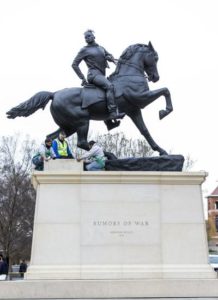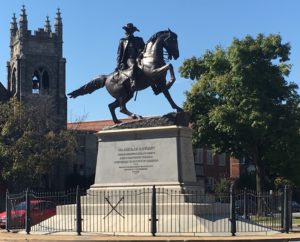This week in Richmond, Virginia, the Capital of the Confederacy a monumental shift took place, literally, with the erection of a new statue, a young black man astride a horse. That statue by Kehinde Wiley, entitled “Rumors of War”, installed in front of the Virginia Museum of Fine Arts, is located a short distance from a famous row of statues of Confederate war heroes and generals along Monument Avenue. Those statues, installed in the early 20th century, celebrate the Southern “Lost Cause”, the idea that the Confederacy, rather than being a defender of slavery, was a just and heroic effort, bolstered by the primacy of states’ rights. The era when the statues were erected was also the time of the Jim Crow Laws, which institutionalized segregation and the inferior status of African-Americans in all spheres of public life.
One of those statues, of Confederate General J.E.B. Stuart was, according to Wiley, the inspiration for his own statue. The Stuart statue was the first to be erected on Monument Avenue, in 1907. According to the Richmond Times-Dispatch, when Wiley, on a visit to Richmond, first saw Stuart’s statue, it “filled him with dread”. As an African-American artist, that reaction is quite understandable. As a White Northerner, coming to Richmond in the 1970’s, I had a less visceral reaction to the Lost Cause iconography, one of surprise. In civics class in Illinois (“Land of Lincoln”) in the 7th grade, we understood that the South not only lost, but did so defending the cruel institution of slavery. My assumption was that folks in the South would much rather just forget that whole episode of American history. Imagine my surprise on seeing huge statues of the folks who were on the wrong side of history.
“Rumors of War” is of the same monumental scale as those of Stuart and the other Confederate heroes. The black man featured is no shrinking violet. He boldly sits astride his powerful horse, with looks that celebrate the contemporary young black American male: dreadlocks, ripped jeans, hoodie. In that way, the statue is not just a counterpoint to Stuart, it is a defiant celebration of young black men, a group not widely celebrated in the US today. As cited in the Richmond Times-Dispatch, Wiley wanted to suggest through the statue that US society “say yes to black men”.

